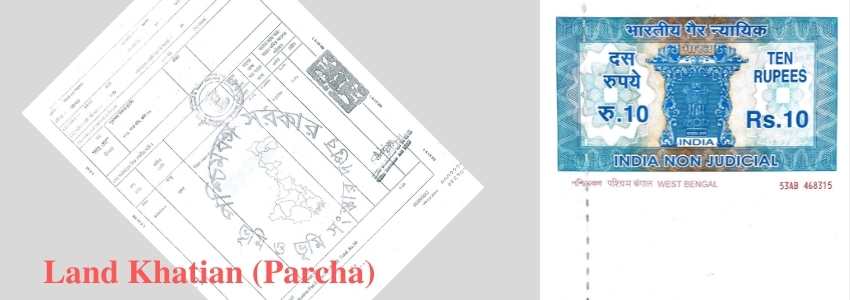Table of Contents
What is Land Khatian, Porcha, or Parcha?
Land records are yet another official record. The full title of this document is the Record of Rights or ROR for short. Its certified copy is referred to as Parcha, Porcha, or Land Khatian. The Traverse Survey, Cadastral Survey, Khanapuri Bujharat, Attestation, Drafting of Records, Settlement of Complaints, and Final Record Preparation and Publication are some of the procedures used to create the ROR.
What exactly do the terms LR Khatian, RS Khatian, and CS Khatian mean?
The type of Record of Right (Land Khatian) that is currently prepared is known as LR Khatian. which is referred to as one man, one Khatian, or one Land Khatian per individual. Additionally, the entirety of this LR Khatian refers to land reform. RS Khatian came before LR Khatian. Revisional Survey is the full meaning of the word \”RS.\” It is to be noted that you may obtain free information about RS Khatian of Rajarhat Block of Mouza Krishnapur from our website and may even download a copy of RS Khatian (RS Parcha) from here. Anyhow, C.S. Khatian is the RS Khatian\’s predecessor. And the \”Cadastral Survey\” is the full meaning of the word \”CS.\”
What are the stages of preparation for Khatian or Porcha IN West Bengal?
Although briefly stated, a Mouza map is prepared using a theodolite in the Traverse Survey in accordance with Section 51 of the Land Reforms Act, which is an internal and proprietary matter of the Government Department. The process of starting ROR record begins with map creation. It is crucial to note that a Mouza can occasionally consist of one or more villages that are recognized by land officials. Revisional Survey, also known as RS Record or RS Khatian, is the final record based on Cadastral Survey, or CS Khatian, that has been created step-by-step from 1953 to 1963.
All of the information about a single landowner or group of landowners is contained in the RS Record or RS Khatian in the form of a form, including 1. Mouza name, 2. the name of the police station, 3. the name of the district, 4. the Khatian number, 5. the name of the zamindar, 6. the Harahari Khajna, 7. the plot number, 8. the class of the land, 9. the total amount of land, 10. the owner\’s share of the total land, etc. requests should be made to the Land Reform Office of the relevant block in order to obtain a certified copy or transcript of this certificate, also known as RS Khatian or RS Parcha.
What is KB Khatian (Parcha) or KB settlement?
Depending on the Revisional Settlement or RS Khatian, the new recording is called Khanapuri Mandarat. Khanapuri refers to all of the Dag-related information, including its current owner and various registration-related details, on the basis of which the hearing is conducted. This approach is referred to as Khanapuri understanding. This step involves producing KB Khatian, also known as KB Parcha or Manual Porcha, in accordance with the “One Man One Khatian” (OMOK) system.
What does the “Attestation” Stage in Land Recording Mean and what does Khasra Record of Mouza mean?
In the event that the KB Khatian contains an error or other issue, the written objections submitted to the concerned Revenue Officer at the Attestation stage are subject to hearings from all parties before the officer in question publishes the newly revised record through it is to be noted herein that the revised Land Khatian is more accurate and error-free at this point because it is based on the evidence and has been verified by looking over the necessary documents or certificates to support possession and ownership of the property.
If a plot is divided, the Revenue Officer gives the new fragmented plot a new plot number. The plot along with the northern boundary is marked with the old number in this instance, and the new plot is easily identifiable by its new number or bata Dag. All attested Khatians which are duly issued by the State Government and record the cess shall bear the signature and date of the concerned Revenue Officer. Following the attestation of each Khatian of a Mouza, the concerned revenue officer publishes the Draft or Khasra Records of the Mouza and issues public notices informing the public of the date and location for a free inspection of the Draft or Khasra Records.
What does the “3 Dhara Kaaj” (৩ ধারার কাজ) in Land Recording mean?
Within 30 days of viewing the Draft or Khasra Records, any objections or disputes must be made in writing to the relevant Revenue Officer, stating the specifics of the objections, using the prescribed form (Form No. 9). After hearing from all of the Petitioner and Opposite Party and considering all of the land ownership documentation, the concerned revenue officer passes the order. After these objections have been heard and taken into account in accordance with Section 51A Sub-section 1 of the West Bengal Land Reforms Act, a new record is published. This revised record is referred to as the Final Published record (FP Record), and this process record is known in plain Bengali as \”3 Dhara Kaaj\” (৩ ধারার কাজ), a term that has gained popularity since the Bengal Tenancy Act of 1885.
What does the “7 Dhara Kaaj” (৭ ধারার কাজ) in Land Recording mean?
The public may review the revised final published record for free for 30 days, and they have a year to object to any errors or incorrect data that were added to it. Objections must be made in writing and include all relevant details, and they must be submitted to the appropriate Review Officer using Form No. 9 (Specification Form). Following hearing from all the concerned parties and a thorough examination of all the land ownership records, land khatians, the concerned Review Officer issued the order.
The concerned review officer amends the record after hearing these objections in accordance with Section 51A Sub-section No. 4 of the West Bengal Land Reforms Act, and a copy of the subsequently revised Khaitan is available from the relevant Block Land and Land Revenue Office (BL & LRO) and this process of record is known in plain Bengali as \”7 Dhara Kaaj\” (৭ ধারার কাজ), a term that has gained popularity since the Bengal Tenancy Act of 1885. It should be noted that the aggrieved party may file an appeal before the District Land and Land Reforms Officer under Section 51A Sub-section 5 of the West Bengal Land Reforms Act, 1955 against the aforementioned order issued by the relevant Revenue Office (RO) if the aforementioned objection petition is denied for any reason or if a decision is made against any party.
Conclusion
Land exchanges and ownership changes are ongoing processes. Additionally, land records are required for housing loans or mortgage loans for home construction, the approval of building plans, the payment of municipal and panchayat taxes, and mutation; however, physical or online mutation applications can only be filed for record alterations or other corrections in Land Khatian in accordance with Section 50 of the Land Reforms Act in regions where the aforementioned sections have been implemented.
জমির খতিয়ান বা পর্চা [Parcha or Khatian] কি?

জমির নথি আরেকটি সরকারী রেকর্ড। এই নথির সম্পূর্ণ শিরোনাম হল রেকর্ড অফ রাইটস বা সংক্ষেপে ROR। এর প্রত্যয়িত অনুলিপিকে পরচা, পর্চা বা জমির খতিয়ান বলা হয়। ট্র্যাভার্স সার্ভে, ক্যাডাস্ট্রাল সার্ভে, খানাপুরি বুজারত, প্রত্যয়ন, রেকর্ডের খসড়া, অভিযোগের নিষ্পত্তি, এবং চূড়ান্ত রেকর্ড প্রস্তুতকরণ এবং প্রকাশনা হল ROR তৈরির জন্য ব্যবহৃত কিছু পদ্ধতি … [More]
